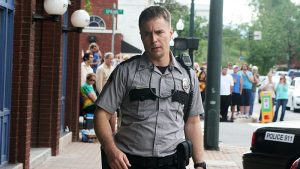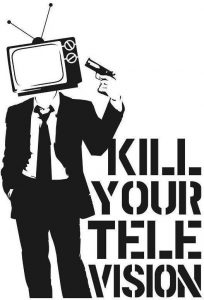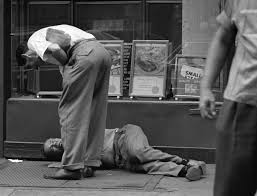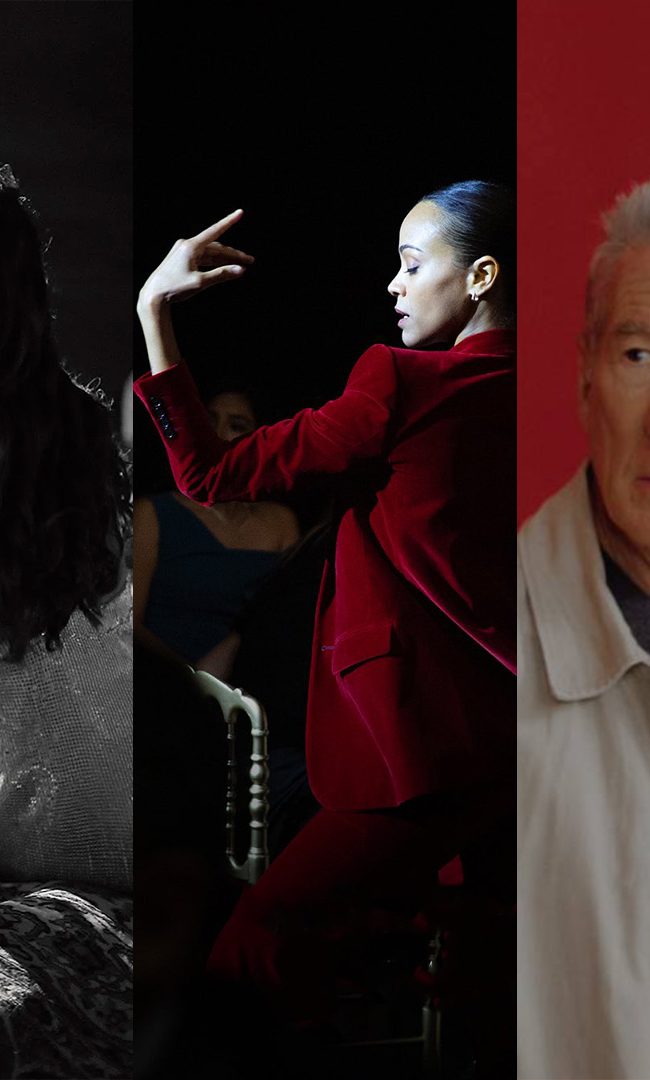ON THE FRINGE: Loquacious introduction + On the Bowery (1956)

Mathew Klickstein
(Hammer to Nail is excited to bring author and filmmaker Mathew Klickstein on-board with his new column, On the Fringe)
Everybody thought I was crazy to do it.
After investing my late teens/early twenties into LA’s dream factory, capped with the cherry of three separate stints in New York City, I was off to an apartment I’d found above a yarn store in an Iowa town so small, its population barely rivaled that of my high school graduating class back in powder-blue-collared Southern California.
I’d taken the opportunity I’d been given, courtesy some income from a book deal, promise of freelance writing work to come and – most crucially – a remote casting producer gig for a show on Food Network, to have my own Steinbeckian experience throughout those parts of the country I had such an uncanny urge to explore.
True, I have a tendency of not being able to sit still. And mixed with a hearty dose of contrarianism, my freewheeling adventures and misadventures throughout the country were also about personal fulfilment. It was fun going to so many different places, and meeting and working with so many different people in cities and states that friends of mine back in LA and NYC asked at times, “Can you send me pictures? What does it actually look like there? Do they have buildings and things?!”
Perhaps arrogantly, naively, I aspired to be the kind of creative producer who would be able to tell the story as suggested by a quote from Robert Darnton’s The Great Cat Massacre in the introduction of my book Nerding Out: “If some way could be found to penetrate into the worldview of the masses and study the values and attitudes of people in the bottom ranks of society, a whole new dimension of history would open up.”
Hoping to be more on the side of Barbara Ehrenreich’s Nickel and Dimed and less the rich dillitentate sung about in Pulp’s Common People, I molded myself into a contributive member of each community where I lived. I penned local arts and culture articles, lectured at schools/seminars/libraries, and became close with the service people and regulars at the coffee shops, bars and restaurants I frequented. On particular occasions of punch-drunk narcissism, I saw myself as continuing the work of the master himself, Studs Terkel.
As time went on, I continued to feel, despite a few timorous shuffles forward (or to the side), that there remains a blinkered love affair with certain classes and sectors of characters/storylines in television and film that results in more aspirational, often fantastical, representations than those of authentic experiences of the vast majority of Americans today.
Productions imbued with the integrity of TV magnate Norman Lear’s impressive run throughout the seventies and eighties seem fewer and far between at present. Fortunately, we’re nearing the continuation of Roseanne, a series that was bold enough to dedicate an entire episode to the frustration of waiting on line at a local tax office and which was said to be one of the only television shows Stanley Kubrick could stomach due to its unvarnished sheen of reality.
Case in point: This past Thanksgiving, I found myself with my brother-in-law at a working-class neighborhood dive bar up the street from my mother-in-law’s, nestled in the rural Illinois hinterlands.
Stranger Things was playing on the television, and I laughed my way through most of the episode along with the regulars and bartender who pointed out everything hilariously wrong with each moment of the supposed representation of small-town midwestern life (“That kid would already know how to fire his gun! And it would already be loaded! What the hell is wearing?” etc.).
You could only imagine the raucous, comfortably inebriated uproar that ensued when Ashton Kutcher’s wildly popular The Ranch came on next.
There has concurrently been a plangent backlash against the award-winning Oscar contender Three Billboards Outside Ebbing, Missouri for its depiction of Sam Rockwell’s racist cop, with others championing its no-holds-barred articulation of apoplectic

rage viz. the MeToo/TimesUp ethos. All but absent from the public square is the observation being made by people I know in places such as Missouri and Kansas: Even with its outstanding pedigree of seasoned actors performing at their highest level, these friends of mine – filmmakers, professors, journalists and rank-and-file lumpen alike – see Three Billboards as a cartoonishly superficial and almost offensively inaccurate portraiture of the contemporary American small-town.
Beyond these examples, far too many current television series and films that do showcase life outside the exciting, glamorous Big (coastal) City too easily succumb to the same trite and supercilious plotline: A wily firebrand has frantically fled from his or her hometown to NYC or LA (or is attempting to do so), but must go back to (or stay in) in his/her Podunk town due to some kind of melodramatic family emergency.
Now – oh, dear! – s/he must contend with his/her adorably, laughably backwards family members and old friends/exes back home. How these people are able to afford traveling so easily or taking so much time off from work is rarely if ever addressed; but, that’s part and parcel of the softball quality of it all, ain’t it? There’s ostensibly never a problem with breaking one’s lease, nor the hair-pulling experience of having to find a replacement roomie last-minute in these films and shows.
Indeed, when it comes to productions that show us those ever-ubiquitous young people trying to “make it” in the City, we as viewers are rarely privy to the actual challenges faced beyond the lives of those subsidized by parents or other loved ones. Where are the five-story walk-ups crammed with six roommates? Where are the broken-down stoves with only one operating burner? The one filthy toilet demanding a special “trick” for proper flushing? The incessant, relentless noise of neighbors blaring video games, TVs and music along with the all-hours honking cars and revving motorcycles outside the thin-as-a-sheet windows?
More adult, sophisticated and domestic storylines away from those of wet-behind-the-ears hotshots vying to become chefs, artists, filmmakers, actors, musicians or writers that do (rarely) take place on the outskirts of central hipster hubs are simply so often relegated to the stuff of histrionic soap operas.
When there are attempts made to portray “real,” everyday people, we just as frequently end up with the kinds of actors and actresses – even as peripheral slice-of-life background – who are at best, as The Simpsons so astutely puts it, “TV-ugly, not ugly-ugly.”
These familiar tropes might make for more accessible, more entertaining and less uncomfortable experiences for audiences and, significantly, advertisers/sponsors/streaming services. But they also cast a distorted view of the vast majority of homes around the country.
How are we to communicate and find solidarity with one another if we don’t even have a basic understanding of what’s actually going on outside our own locales, off and across the country, via the main way (films/television) typical people have the ability to observe their fellow Americans on a regular basis?
Sure, this brand of overblown artifice boosted by media/marketing puffery is nothing new in cinema. Even at the inception of silver screen mainstreaming in the 1930s/40s, Mae West bemoaned the ersatz “genuine article.” These “synthetic stars,” as West described them in her autobiography, were concocted from various ingredients including “a world of mad, wild publicity,” and “[o]ften the result was like something created in the laboratory of a mad scientist.”
Certainly, the very idea that all movies and television should be 100% real-deal is an absurd one. There should be entertainment that is escapist in addition to that which is enlightening or edifying. Chaplin’s Tramp and the Marx Bros. were no mere luxury for those surviving the Great Depression who needed to laugh at the over-the-top shenanigans of fellow down-and-outters.
But it’s worth noting that we may be in unprecedented waters here in 2018. We’re living in a time where more truthful representations of people who happen to live outside the media/entertainment/tech bubble are desperately needed as a countervailing force against the barrage of disingenuous pap inundating our screens, big and small.
 Trust in the Media as an institution continues to be on a visibly precipitous decline, with the Media Insight Project (a collaboration of the American Press Institute and the Associated Press-NORC Center for Public Affairs Research) recently reporting that only 17% of Americans believe the Media to be“very accurate.”
Trust in the Media as an institution continues to be on a visibly precipitous decline, with the Media Insight Project (a collaboration of the American Press Institute and the Associated Press-NORC Center for Public Affairs Research) recently reporting that only 17% of Americans believe the Media to be“very accurate.”
Neologisms such as “fake news” are aggressively volleyed back and forth between pundits across the political spectrum. Garish award ceremonies experiencing dwindling ratings might further suggest a loudening discord between the creators/arbiters of the entertainment/media industry and the actual consumers on the ground floor scratching their heads at what they see onscreen.
It’s perhaps, then, an ideal time to revisit films that seem to have a far tighter grasp on the pulse of our collective heartbeat than the standard fare doled out on our consumption conveyor belt running faster and faster than anything Lucy Ricardo and her dear, harried friend/landlady Ethel ever had to contend with at the chocolate factory.
True, for obvious economic reasons, these films depicting the soi-disant genuine American experience outside trendier enclaves are few and far between. But those diamonds in the buttery popcorn do continue to shine through the all-consuming box.
Take as clarion example this year’s honorary Oscars, one of which will at long last be bestowed upon the much-deserving filmmaker Charles Burnett, whose 1978 black-and-white masterpiece Killer of Sheep has been a major inspiration for this series since I first began pitching it a few months back.
As a humble tip of the hat to Killer of Sheep and similar productions, Hammer to Nail now presents a chronicle of films that courageously attempt to authentically illustrate what it means to live on the fringes of American citizenry, from the birth of modern cinema in the 1950s through today.
In each installment of this series, I will discuss both the individual film and others of its ilk that best encapsulate the current time it was released. For those who wish to work ahead, as it were, the list will be as follows:
- On the Bowery (dir. Lionel Rogosin, 1956)
- The Exiles (dir. Kent MacKenzie, 1961)
- Alice Doesn’t Live Here Anymore (dir. Martin Scorsese, 1974)
- Killer of Sheep (dir. Charles Burnett, 1978)
- Permanent Vacation (dir. Jim Jarmusch, 1980)
- Gas, Food Lodging (dir. Allison Anders, 1992)
- Shotgun Stories (dir. Jeff Nichols, 2007)
- Wendy & Lucy (dir. Kelly Reichardt, 2008)
- Beasts of the Southern Wild (dir. Benh Zeitlin, 2012)
- Tangerine (dir. Sean Baker, 2015)
On the Bowery (dir. Lionel Rogosin, 1956)
We begin with On the Bowery, a film so raw and realistic to its time, place and “characters” (such that they are), that it is often referred to as a documentary. Bowery in fact earned an Academy Award nomination in 1957 for Best Documentary Feature and became the first film by an American director to win the award for Best Documentary at the Venice Film Festival.
There were nevertheless a number of variable scripts written, re-written and co-written by director Lionel Rogosin and his nebulous team of filmmakers throughout production. But much of what ended up onscreen was the result of improvisation involving actual experiences Rogosin and his cast of non-actors shared during the months the director spent researching the multitude of so-called “Bowery bums” depicted in his film.
Profoundly influenced by Robert Flaherty’s genre-making fusion of documentary/narrative filmmaking, 1922’s Nanook of the North, as well as the emerging works of Italian neorealism that again self-consciously blurred the lines between reality and fiction, Rogosin took an unrepentantly Frederick Wiseman-esque, fly-on-the-wall approach to his nearly non-existent plot. Rogosin’s characters develop less than they engage in a sysyphian cycle of dissipation quite literally under the dismal shadow of the grimy Third Avenue El.
This merciless objectivity allowed Rogosin and his team to achieve a cold, existential tone throughout that leaves the viewer feeling as though he’s wandered into some place he doesn’t belong. Whole manic sequences go by with unheralded characters coming and going, accomplishing little aside from eking ever closer to the possibility of a place to “flop” for the night, another few scammed beers and a hint of day labor for the morning to come.
One of the two or three “protagonists,” if you can call him that, drunkenly collapses on the sidewalk, only to awake to find the suitcase filled with all his earthly possessions stolen. What  would normally be a traumatic plot device is hardly mentioned again; it’s merely another spoke in the pathetic circadian rhythm ruling the lives of these consistently befogged men.
would normally be a traumatic plot device is hardly mentioned again; it’s merely another spoke in the pathetic circadian rhythm ruling the lives of these consistently befogged men.
As a means of entryway into the darkest side of the dreg lives for the general audience, Rogosin employs a lush, upbeat score that – at least in the beginning – grants the viewer a glimmer of hope as the picture proceeds. There’s echoes of Prokofiev’s Peter and the Wolf here that underline the first half of the film with a sense of a picaresque adventure. One almost expects the avuncular voice of a Walt Disney nature documentary narrator to pipe in and remind us that we’re merely watching the daily ups-and-downs of those rascally characters who happen to inhabit New York’s Bowery Row.
As the boredom, loneliness and mundane routine of the hapless wastrels onscreen intensify a la Orwell’s 1933 memoir Down and Out in Paris and London, the music and overall timbre of the film shift dramatically. An ominous katzenjammer cloud takes over, as whole episodes devolve into a blurry swirl of bar brawls and discordant “dialogue” punctuated by an atonal music that more closely resembles cabaret-inspired jam sessions of the Doors.
From here, what little “narrative” that remains is interspersed with what is likely actual documentary footage of men – scads of them – lying prostrate on the sidewalk in the most uncomfortable of positions after having passed out.
So too do the men in the bars fade into mere mise-en-scène, less haunting the smoke-filled environs they populate than appearing as plastered parts of the walls, chairs and floor.
For the barest sense of optimism, an arbitrary scene takes place – that feels as though it’s happened plenty of times before – in which our men find themselves in a church, listening to a (rehabilitated) preacher refer to their “home” on the Bowery as “Skid Row,” quoting a newspaper article that is no less brutal in its observing the area as “the saddest and maddest street in the world.”
Without giving any spoilers here, it’s clear by the end of the film that there’s no way out for the men on the Bowery we’ve gotten to know (somewhat) over the span of the hour-plus glimpse into their messily Bacchic lives.
Off-screen, lead player Ray Salyer famously turned down a contract that could have led him down the path of Hollywood stardom after the film’s release. Salyer instead demanded to be left alone, remained drinking on the Bowery and died six years later.
Another principle player, Gorman Hendricks, similarly died … before the film ever had a chance to be screened.
On the Bowery can easily be mentioned in the same breath as such works as Eugene O’Neill’s bar-room drama The Iceman Cometh and the ne’er-do-well travelogue of On the Road, published on the heels of Bowery’s release.
Internationally, there are clear affinities in aesthetic and content with the likes of Hector Babenco’s Pixote, the Mexican films of Luis Buñuel such as Los Olvidados, Britain’s “Angry Young Men” pictures such as Tony Richardson’s The Loneliness of the Long Distance Runner and early works of the French New Wave, particularly Truffaut’s The 400 Blows and Robert Bresson’s Mouchette.
Clear connections with the film exist too with the “Imperfect Cinema” coming out around the same time in Cuba: films both about and produced in the harshest of situations that presaged the 1970s “Theatre of the Oppressed” scene in Latin America and Europe.
Considering the largely improvisational and atavistic methodology Rogosin employed, it’s no wonder he traveled in the same crowd of fellow pioneering American independent film bellwethers John Cassavetes, Shirley Clarke, Jonas Mekas, Maya Deren and Stan Brakhage.
We’ll see what this filmmaking sensibility can produce when cameras are panned westward toward Los Angeles’ Bunker Hill District for next week’s film, 1961’s The Exiles.
MATHEW KLICKSTEIN is (for the time being) a Boulder-based writer/filmmaker whose most recent film is On Your Marc, a documentary about 80s/90s TV icon Marc Summers. His next book, Springfield Confidential: Jokes, Secrets, and Outright Lies from a Lifetime Writing for The Simpsons (co-written with lifetime series writer/producer Mike Reiss, foreword by Judd Apatow), will be released through Harper Collins this June. You can keep up with his regular shenanigans at MathewKlickstein.com.
– Mathew Klickstein











